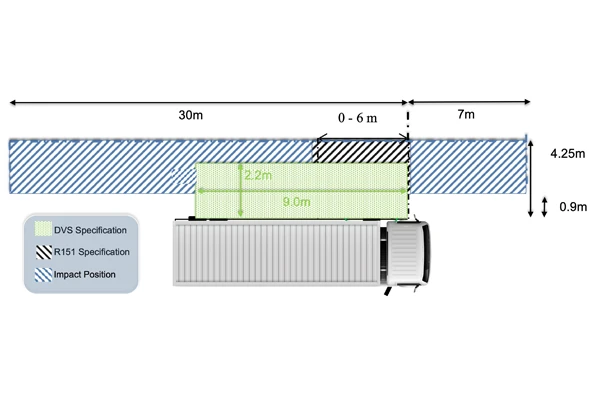Progressive Safe System (PSS)
Quick Links
The Progressive Safe System (DVS2)
The Transition from Safe Permit to Progressive Safe System (PSS)
Previously, the permit for additional safety equipment for HGVs was referred to as a “safe permit.” However, starting in October 2024, it will be known as the “Progressive Safe System” (PSS). This transition is part of the broader effort to enhance safety standards. The PSS introduces the latest advancements in technology, which means that some operators may need to replace their existing equipment with new, more advanced technology.
Progressive Safe System (DVS2)
Advanced Technology in Predicting Collisions for DVS Compliance
The PSS requires a significant shift in technology. Unlike the previous safe permit, which required obstacle detection systems on the nearside, the Progressive Safe System demands technology that can predict collisions based on the trajectories of the vehicle and the vulnerable road user (VRU). This prediction is crucial in determining if a collision is imminent. Furthermore, the system includes a specified alarm strategy designed to alert the driver to the severity of the situation.

The Progressive Safe System includes new additions:
1. Active Side Sensor Systems that can:
2. Front Detection System or Moving Off Information System (MOIS) that requires:
Differentiate between moving and stationary objects.
Predict collisions “based on the trajectories of the vehicle and the vulnerable road user (VRU) to calculate if a collision is imminent.
Provide a specified alarm strategy to warn of the severity of the situation.
Two alarms; one when the driver detects a VRU when preparing to move off and one when the vehicle detects a VRU as it has begun its forward manoeuvre.
When the vehicle is stationary; the system must provide a signal to inform the driver of any VRU’s who are in or about to enter the critical blind spot in front of vehicle.
The collision warning must be a combination of at least two modes from an optical signal, acoustic or haptic.
Understanding UNECE Regulation 151 and 159 vs. DVS Requirements
It’s important to clarify the distinctions between UNECE Regulation 151 and 159 and the DVS requirements. These regulations have different detection areas. For instance, in terms of side detection, Regulation 151 allows for a specific gap, whereas DVS mandates detection right up to the side of the vehicle. The same applies to front detection, where Regulation 159 allows a gap, but DVS requires detection right up to the nose of the vehicle. The General Safety Regulations (GSR) reference whole vehicle homologation rather than individual components. Therefore, a product meeting Regulations 151 and 159 may not necessarily meet DVS requirements at the aftermarket stage.
DVS and R151 Comparison

DVS and R159 Comparison

DVS Equipment Certification and Compliance
The PSS outlines specific test procedures, placing the responsibility on DVS equipment manufacturers to confirm that their products meet the requirements through a ‘sensor functionality statement.’ Manufacturers must also provide details on how their products integrate with other systems without compromising safety-critical aspects or vehicle performance. Products with an E-mark certification will meet these requirements.
Evidence needed to comply with the PSS
Operators will need to upload documentation with photographic evidence of compliance. This documentation will be crucial for monitoring and enforcement. Any non-compliance issues identified later can be readily traced back to the manufacturer used. It is essential for fitters to confirm that the sensors fitted to the vehicle are active and installed in compliance with the technical PSS specification. This approach will promote both product and installation quality.

Photo 1
Must show the front and nearside of the HGV showing the front number plate.

Photo 2
Must show the rear and nearside of the vehicle including the rear number plate.
Sensor Functionality Statement
The PSS sets out specific test procedures and it is the responsibility of the DVS equipment manufacturer to confirm that products meet the requirements via a ‘sensor functionality statement.’ This should include details of how the products link with other systems and confirmation that they do not adversely affect any safety critical aspects or performance of the vehicle. If a product has an E-mark it will meet these requirements.
The document will need to be uploaded by the operator. If there are any non-compliance issues identified at a later date, it will be easily identified from the manufacturer used. Fitters will also need to confirm that the sensors fitted to the vehicle are active and fitted in compliance with the technical PSS specification.
Brigade Service Partners are professional auto electricians that are trained and approved to fit Brigade equipment.
How Brigade can help
Brigade Electronics has a range of products to help operators meet the requirements of various specifications including the Progressive Safe System (PSS) for the Direct Vision Standard (DVS). Brigade’s team of experts works closely with road safety associations and charities to provide the best and most up-to-date advice. Interpreting various specifications and understanding the terminology can be a minefield for operators. For example, references to ‘shall’, ‘should’ and ‘may’ in the Direct Vision Standard depict whether a requirement is mandatory, recommended or permitted and transport managers can be left confused.
Brigade has provided advice to many OEM and OES suppliers and continues to work with the aftermarket to make sure that vehicles are compliant. In this role, Brigade also ensures products are fitted to maximise their safety potential.
For a free no obligation consultation on the Direct Vision Standard, please contact us for an appointment.
Where in London is the DVS Enforceable?
Our DVS map below outlines the area of London where the DVS regulation is currently in force and where permits are compulsory. Don’t forget this will apply to all vehicles weighing more than 12 tonnes, whether they are from the UK or traveling into London from overseas.

Contact Brigade
Would you like to contact Brigade Electronics? Please follow the link below.
Find Your Nearest Distributor
We have a worldwide network of over 500 Brigade approved distributors and installers.
